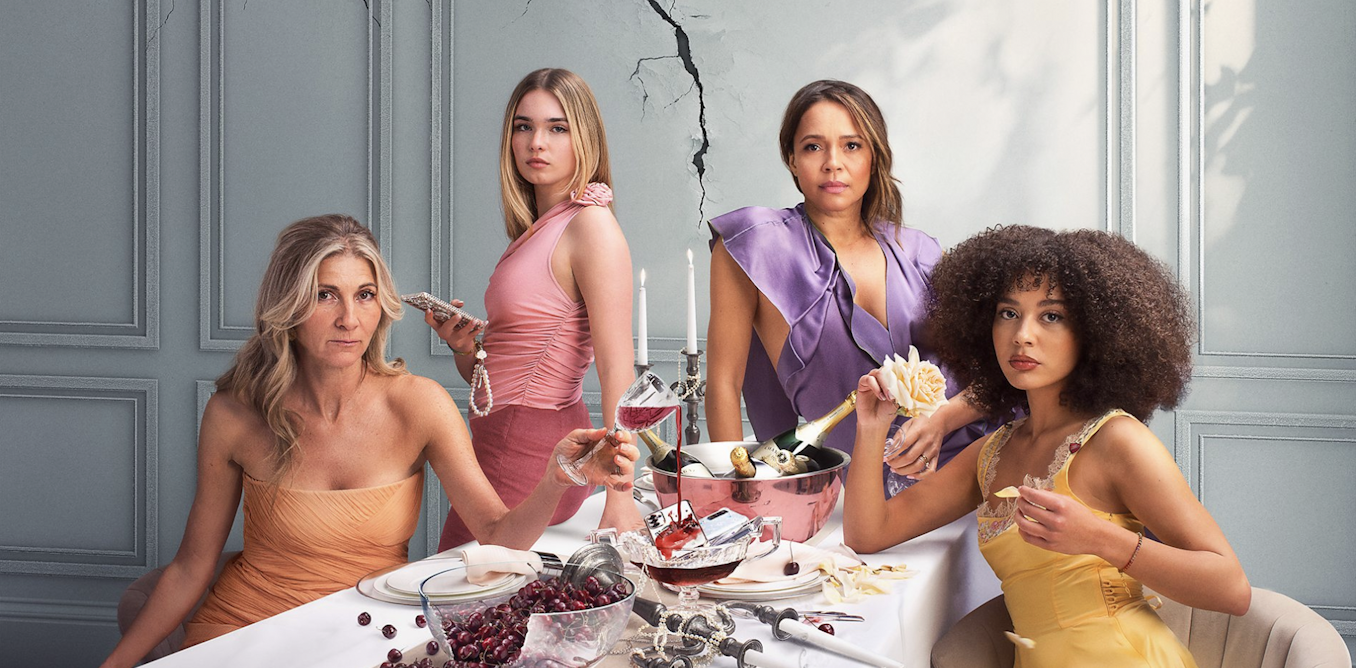Please note this piece contains spoilers for Wild Cherry.
Critics have compared Nicôle Lecky’s six-part BBC thriller, Wild Cherry with the critically acclaimed Netflix drama Adolescence. But that would be unfair.
The former is a glossy thriller that critiques the lives of wealthy Surrey schoolgirls and their mothers, while the latter is a serious and powerful social commentary on the potential impact of misogynist online influencers.
Both dramas address the issue of teens on social media, explore “sexting”, and question the degree to which parents are aware of their teens’ online life. But Adolescence is dialogue-driven, innovative in style and offers a sympathetic view of the parents and their troubled and violent son.
In contrast, Wild Cherry’s thriller/melodrama form mirrors US “eat-the-rich” dramas such as White Lotus by focusing as much on the trappings of wealth (sumptuous interiors, gated communities, expensive landscaping, fancy cars) as on dialogue and plot. It is this aspect that leads to the key problem with Wild Cherry: it satirises the lives of the British upper middle class, while also trying to address the more pressing challenges of mother-and-daughter relations in the digital age.
As Lecky, the series’s show-runner and a key cast member, has stated in an interview: “How do you parent teenage girls when you have grown up in such a different time, without social media?”
Where Adolescence depicts ordinary people in realistic settings, Wild Cherry’s critique of the wealthy initially relies on negative stereotypes of women, girls and mother-daughter relationships. This makes it difficult for viewers to sympathise when the full plot unravels and the pressures and problems of girls’ social media use are brought to the fore.
Mean girls and not-so-perfect mothers
One of the ironies explored in the programme is that the central protagonist, aristocratic Juliet, is basking in praise for writing a parenting guidebook – blissfully unaware her own daughter is pressuring school friends to pose provocatively for a monetised secret online catalogue.
The mothers are portrayed as shallow, competitive and woefully out of touch with their daughters. Reinforcing negative “yummy mummy” stereotypes, the series presents the mothers as either leisured housewives (Juliet) or successful “mumpreneurs” (Lorna, without any obvious reference to her professional activities).
Similarly, the representation of teenage girls – specifically Juliet’s mean-spirited and sullen daughter Allegra, and her closest friend Grace – revisits a multitude of sexist screen stereotypes of young women. Reproducing the mean-girl stereotype analysed by critics such as Alison Winch and depicted onscreen in productions such as Heathers and Gossip Girl, the girls’ friendships are defined through rivalry, bullying and hierarchy.
Wild Cherry also fuels longstanding moral panics around teenage girls’ “dangerous” emergent sexuality by depicting the girls’ sexual self-presentation and their desire to illicit sexual attention.
This stereotype has also been analysed and critiqued by feminist cultural critics, including Valerie Walkerdine and more recently, Jessica Ringrose in relation to depictions of girls’ internet usage. The authoritative voice of the female police officer echoes the programme’s reductive and hostile view of young women, stating: “I don’t put anything past teenage girls” – also the title of the final episode.
BBC Studios / Lesley Edith
Subverting stereotypes
The first four episodes of Wild Cherry present the female characters through a stereotypical lens as pampered middle-aged women, bad mothers and wild daughters whose problems seem entirely self-generated. However, Lecky sets up these female stereotypes only to reveal male manipulation, by both younger and older men, as the central catalyst for the exchange of sexual online images of girls (revealed in episodes five and six).
Wild Cherry therefore becomes a feminist tale, rather than a tale of toxic femininity, as the story takes a turn towards a more sympathetic representation of mothers and daughters in its resolution. The mothers eventually assert agency and take revenge on the male characters, while the teenage girls reject male approval and seek solace from their mums. Mothers and daughters are ultimately united against patriarchal power.
As the story unfolds, Wild Cherry highlights the dangers of girls internet usage linked to male power and control. Yet, the series is no Adolescence. It’s unlikely to be considered serious social commentary due to its sensationalised narrative and – despite the ending – its overriding vision is still a stereotypical one in which mother-daughter relations and female friendship are presented as riven with conflict.
This view conflicts with much research that demonstrates the selfless bond between mothers and daughters. It is also well-established that female friendship brings huge psychological and emotional benefits for women throughout their lives.
These more accurate and uplifting narratives of mothers, daughters and female friendship are represented in popular screen series such as The Gilmore Girls and more recently Ginny and Georgia (mothers and daughters), and Derry Girls, Geek Girls, and Sex Education (teenage girls).
In this sense, Wild Cherry is a missed opportunity to explore girlhood in the digital age from the point of both mothers and daughters in the sympathetic manner that Adolescence did for fathers and sons.

Looking for something good? Cut through the noise with a carefully curated selection of the latest releases, live events and exhibitions, straight to your inbox every fortnight, on Fridays. Sign up here.

The post “Wild Cherry is no female version of Adolescence – but it is a modern feminist tale” by Roberta Garrett, Senior Lecturer in Literature and Cultural Studies, University of East London was published on 11/25/2025 by theconversation.com





































Leave a Reply